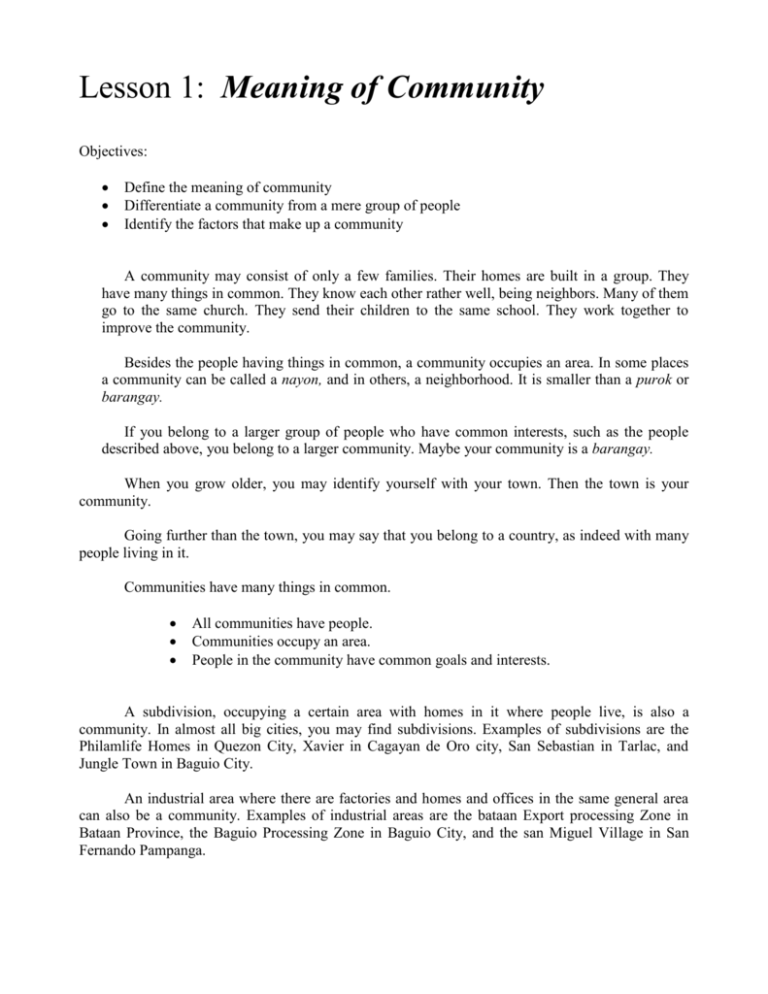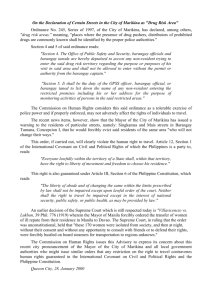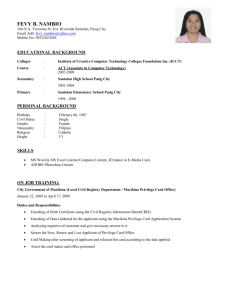Lessons 1-3 - Philippine Swimming
advertisement

Lesson 1: Meaning of Community Objectives: Define the meaning of community Differentiate a community from a mere group of people Identify the factors that make up a community A community may consist of only a few families. Their homes are built in a group. They have many things in common. They know each other rather well, being neighbors. Many of them go to the same church. They send their children to the same school. They work together to improve the community. Besides the people having things in common, a community occupies an area. In some places a community can be called a nayon, and in others, a neighborhood. It is smaller than a purok or barangay. If you belong to a larger group of people who have common interests, such as the people described above, you belong to a larger community. Maybe your community is a barangay. When you grow older, you may identify yourself with your town. Then the town is your community. Going further than the town, you may say that you belong to a country, as indeed with many people living in it. Communities have many things in common. All communities have people. Communities occupy an area. People in the community have common goals and interests. A subdivision, occupying a certain area with homes in it where people live, is also a community. In almost all big cities, you may find subdivisions. Examples of subdivisions are the Philamlife Homes in Quezon City, Xavier in Cagayan de Oro city, San Sebastian in Tarlac, and Jungle Town in Baguio City. An industrial area where there are factories and homes and offices in the same general area can also be a community. Examples of industrial areas are the bataan Export processing Zone in Bataan Province, the Baguio Processing Zone in Baguio City, and the san Miguel Village in San Fernando Pampanga. You will also find what are called compounds. These residentials areas, with homes in them probably owned by a family and relatives, are also communities. One example of a compound is the Madrigal compound in Roxas Boulevard, Manila. Other compounds are found in other towns and cities throughout the countries. In some areas you find groups of people living and working together, perhaps under an employer. Examples of these are the Pineapple farmers and employees of the Philippine Packing Corporation in Bukidnon province and the Sugarcane farmers and employees of Hacienda Luisita in Tarlac province. In a hacienda, the people have their homes, school, health clinic, church, and stores. Their community hall is used for general purposes like dancing, meetings, and parlor games. The Philippine Packing Corporation employs hundreds of people to grow and pack pineapples for export and local consumptions. In one of their camps, Camp Philips, the people have a school, a church, a hospital, several stores and a playground. In the smaller camps the people have basketball and volleyball courts and communities centers where they meet to discuss their common problems and projects. In many of these camps, there are string bands providing music for social events. These are all examples of communities. Perhaps you know of other places where people live together in the same residential areas. In large cities, these maybe blocks. In rural areas, these may be puroks. These communities are not political units. They may belong to barangays or municipalities but they are distinct groups because they may have many things in common. Lesson 2: Physical Environment of the Community Objectives: Identify the elements that make up the physical environment of the community. Describe the physical environment of one’s community. Relate the physical environment of the life-ways of the people. Look around you. Do you live in a community near the see? If so, you should have a beach near by. The beach is a part of your physical environment. Maybe the mouth of a river is near your home. There maybe a road, bridge not too far away. There maybe mountains and hills in the distance. And there maybe building or various type-residence, stores, schools, warehouse, a government buildings. All these are your physical environments. Some parts of your physical environment are natural, meaning; they were made by nature, like beaches, mountains and rivers. But others are made by men like the houses, schools and government buildings. Do you like at the foot of a mountain? There maybe a forest not too far away. That, too is part of your environment. Maybe there is a spring near by or waterfall up in the hills. There are roads and trails. These are all parts of your environment. Do you live in that area, like those in Bulacan or in Panay or Davao? Maybe what you see is flat around; almost most of it is planted with rice or corn. And maybe there are irrigation canals that feed the crops with water. Lesson 3: History of Marikina The Jesuits first came to this valley in 1630. In 1687 this pueblo became a parish and was then known as Mariquina and later on Marikina with the coming of the Americans. The natives had lived along the river and the fertile farms around it. With the industry of the natives and the know-how of the early Chinese settlers (Sangleys), and the money provided by the Mestizos, the farms began to produce rice and vegetables in great quantities until the valley became the country's most prized hacienda. The Chapel at Jesus de la Peña. Built by the Jesuit Missionaries in 1630, marks the foundation of Christianity of the Marikeños. Just like Pasig River whose fertile soil attracted the natives who converted the area into rich farmlands prior the arrival of the Spaniards, the Marikina riverbanks had also long been settled by river-dwellers or taga-ilog. They were the natives whom the Augustinian friars referred to when they explored the areas along the Marikina riverbanks in 1570s and discovered a cluster of huts around a manantial (later called Chorillo and today as Barangka). In its immediate vicinity, the priests built a visita which served as their center for taking care of the spiritual needs of the settlers. On April 16, 1630, Fray Pedro de Arce, apostolic ruler of the Archbishop of Manila, approved the transfer of ecclesiastical control and supervision of Marikina area to the Jesuits. The Jesuits established a mission in a place they called Jesus dela Peña (Jesus of the Rocks) on the west bank of the river. They also invited several Chinese traders and agriculturists to join hands with the natives in launching an hacienda. Two of the first Chinese mestizo families who settled in the poblacion were surnamed "dela Paz" and "de los Santos." The place was beautifully developed and, after a century, the entire hacienda was officially named by the Jesuits in honor of San Isidro Labrador, the patron of the families. The story of how the town got its name "Marikina" is largely based on legends. According to one source, it was Trinidad H. Pardo de Tavera who said the town was named after Captain Berenguer de Marquina who was once a chief executive of the town before Marikina was declared a pueblo in 1787. Another legend has it that the town was named after a priest who was given the instruction to baptize the natives following the establishment of the Jesuit mission. Another source said that the Jesuits named the town after their hometown in Spain, a town along the Charmaga River called Mariquina. Still another story tells of a rich, beautiful and kind woman, Maria Quina, whose fame had spread to a wide area. Then there is the story of a worker telling a priest that the church that was being built at the center of the town was "Marikit-na" (beautiful now.) The name "mariquina" lasted for decades until Pardo de Tavera, early in the years under the US- Philippines Commission, suggested that name be changed to its present name of Marikina. Marikina's history cannot be complete without considering the Tuason clan. A daughter of one of the influential families of Marikina named Doña Teresa de la Paz y de los Santos was married to Don Jose Severo Tuason, the fourth lord of the Hacienda de Mariquina considered to be the biggest private hacienda in the country The Tuasons had emerged as the leading Chinese mestizo family not only in their original place, Binondo, but in the entire colony. The patriarch of the clan, Don Antonio Tuason, made his fortune in the Galleon Trade and was possibly the richest man in the Philippines by the second half of the 18th century. His family ascended the Spanish nobility by a royal decree in 1782 and was exempted from paying tributes for two generations in 1775 as a reward for his loyalty and boundless generosity. To express his gratitude to the King of Spain, Carlos IV, Don Antonio founded a mayorazgo (noble estate) on Feb. 25, 1794, which was approved in the King's decree of August 20, 1795 The Mayorazgo Tuason appeared to be the only noble estate in the Philippines. The successors to the mayorazgo was based on male primogeniture (first born or eldest son). This was not only a Spanish policy but also a Chinese custom. In fact, Son-tua, the original surname of the Tuasons, means "eldest son." The first holder of the mayorazgo was Don Vicente Dolores Tuason. The Society of Jesus was expelled from the Philippines in 1768 and all its properties were seized by the crown. Don Vicente acquired the Jesuits' Hacienda de San Isidro de Mariquina at a public auction in 1794. He paid a total of 33,750 pesos for the said property. Don Vicente's grandson, Jose Severo, first-born son of the third lord of Mariquina, Don Jose Maria Tuason and Doña Maria Josefa Patino y Tuason, married in defiance of familial expectations, Teresa de la Paz. This lady who was called by Jose Severo as "Mariquit na Teresa" when she was being wooed by him, and later on, "marqueza" when she took possession of the Hacienda Mariquina, as well as that of Sta. Mesa (part of the huge property of the Tuasons) in October 1, 1878. Marikina officially became a town in 1787. That same year, it elected its first gobernadorcillo, Don Benito Mendoza. Thirty-four other men succeeded him in that post until 1821. Another long line of 75 town executives called alcalde or capitan were elected until the outbreak of the revolution in 1896. During the Revolution, the local government system was disrupted. But after the proclamation of the Philippine Independence on June 12, 1898 in Kawit, Cavite, President Emilio Aguinaldo attempted to reorganized the local government. Marikina and other towns comprising the Province of Morong and Manila has signed the act of Independence. Aguinaldo proceeded to appoint provincial officials. Don Ambrosio Flores, appointed governor of Manila province, chose Marikina as capital. During the American regime. Marikina was blessed with facilities that responded to the medical/health needs of the residents. One of these was the construction of the Puericulture Center in Barrio San Roque just opposite the old Municipal Building and the Roman Catholic Church. This used to be the office of the Hacienda de Tuason. Following the fall of the Philippine government during the Filipino-American war, the Americans established a military government and started a campaign of pacification. Later, they started appointing town executives called presidente. Vicente Gomez or Tenten was appointed presidente of Marikina in 1900 charged with the restoration of civil order. He convinced the people to return peacefully to their homes and to swear allegiance to the United States. There were some holdouts including two avid followers of Gen. Artemio Ricardo, alias "Vibora," the last revolutionary general to surrender to the Americans. Among the holdouts were Francisco Sanchez, Julian Santos, Gen. Hermogenes Bautista and Julian Cruz. But after sometime, many of the holdouts were convinced to cooperate with the American authorities. A new province out of the Morong District named Rizal was created on June 11, 1901 with Pasig as capital and Marikina as one of its towns. Gen. Ambrosio Flores was appointed governor, while Vicente Gomez, Sr., was appointed presidente of Marikina and served from 1902-1903. He was succeeded in this post by 11 other men, some elected under the Commonwealth regime until the Japanese invasion in 1941. Many Marikeños occupied positions in the provincial and national government before and after World War II. Catalino Cruz, known as "Imong Bokal," was a member of the provincial board from 1920-23. Nicanor Roxas also served as member of the board from 1925-28, and as provincial governor during the Japanese occupation. In 1934, a staunch supporter of Commonwealth President Manuel L. Quezon and a pillar of the local Nacionalista Party, Emilio de la Paz was elected representative of the second district of Rizal to the first national assembly. He was reelected in 1938 and was returned to the postwar House of Representatives in 1949. Emilio was the brother of Wenceslao de la Paz who served as town presidente from 1929 to 1937. He was also the father of Emelito de la Paz who was elected assemblyman to the Batasang Pambansa in 1984. Serafin Salvador was elected to the seat of Emilio de la Paz from 1954-57. He later served in the cabinet of President Carlos P. Garcia. Photo was taken during the Japanese occupation. The Japanese upon arrival in 1942 commandered the house of Domingo Zamora (Inggong Puray) in barrio Sto. Ñino. They used the place as their military headquarters and garrison. Inggong Puray, known nationalist in Marikina, headed a group in 1903 to establish a new religious group to be called "Iglesia Pilipina Independiente" Elected presidente in 1938, it fell upon Dr. Juan Chanyungco to deal with the Japanese occupation forces. He stayed as town executive until 1944 when the Japanese found out his links with the guerilla government. He was arrested by the Japanese authorities but escaped while he was being brought to Montalban (now Rodriguez). With the restoration of civil government under Pres. Sergio Osmeña, rehabilitation of the town started under Enrique de la Paz who was appointed mayor in 1945. He was a nephew of Congressman Emilio de la Paz. With the election of Pres. Manuel A. Roxas in 1946, he appointed Gil Fernando, a pillar of the local Liberal Party, as mayor of Marikina. Fernando was elected mayor on his own in the first postwar local elections in 1947 and served until 1951. He was again elected mayor from 1956 to 1959. Dr. Juan Chanyungco made a comeback in 1951 to 1955. Osmundo de Guzman succeeded Gil Fernando in 1960 and remained mayor until his death in February 1986, a few days before the outbreak of the EDSA Revolution. His 26 years in office were the longest for any town mayor. His term included the martial law years which began in 1972. There was no local election from 1975 to 1980. In June 1975 the Metro Manila Commission was created under Presidential Decree No. 824 integrating four cities and 13 towns, majority of which were in the Province of Rizal. Marikina then became part of the Metropolitan Manila area. Vice Mayor Teofisto Santos served as town executive for a little more than a month until he was ousted by the revolutionary government under President Corazon C. Aquino. Rodolfo Valentino, a dentist by profession and a scion of a shoemaking family, was appointed Officer-in-Charge until 1988 when he was elected mayor on his own. He remained mayor until June 30, 1992 when he lost his reelection bid against Bayani "BF" Fernando. Mayor Fernando was reelected in 1995 and again in 1998. Origin of the name Marikina From a priest name MARQUINA. From a lady name MARIA CUINA From the word MARIKIT-NA Named after a town in Spain MARIQUINA Founding day: April 16, 1630 Cityhood day: December 8, 1996 under republic act 8223. Marikina, a lush valley bounded by mountain ranges by a river, is one of the 14 cities and 3 municipalities comprising Metro Manila. It is bounded on the east by Sierra Madre Mountains and by Antipolo City; on the west, by the Quezon City hills; on the north by San Mateo, and on the south by Pasig City and municipality of Cainta. Land Area (Hectares): 2,150 -Marikina City is divided into 16 barangays-District 1-Barangka -Calumpang -Industrial Valley Complex -Jesus dela Peña -San Roque -Sta. Elena -Sto. Niño -Tañong Prepared by:GROUP III Leader: De Los Santos, Aisa Q. Members: Condes, Ma. Bianca Cruz, Fleur Maria Rica Dalistan, Roseleen Alicia S. Jacobo, Lady Kim Bonifacio, Ericson Caparanga III, Juan Paolo Francisco Jr., Salde Solis, Gilbert IV-SAMPAGUITA SY:2008-2009 - District 2-Concepcion Uno -Concepcion Dos -Fortune -Malanday -Marikina Heights -Nangka -Parang -Tumana Mr.Emerlindo C. Matienzo MAPEH TEACHER IV






